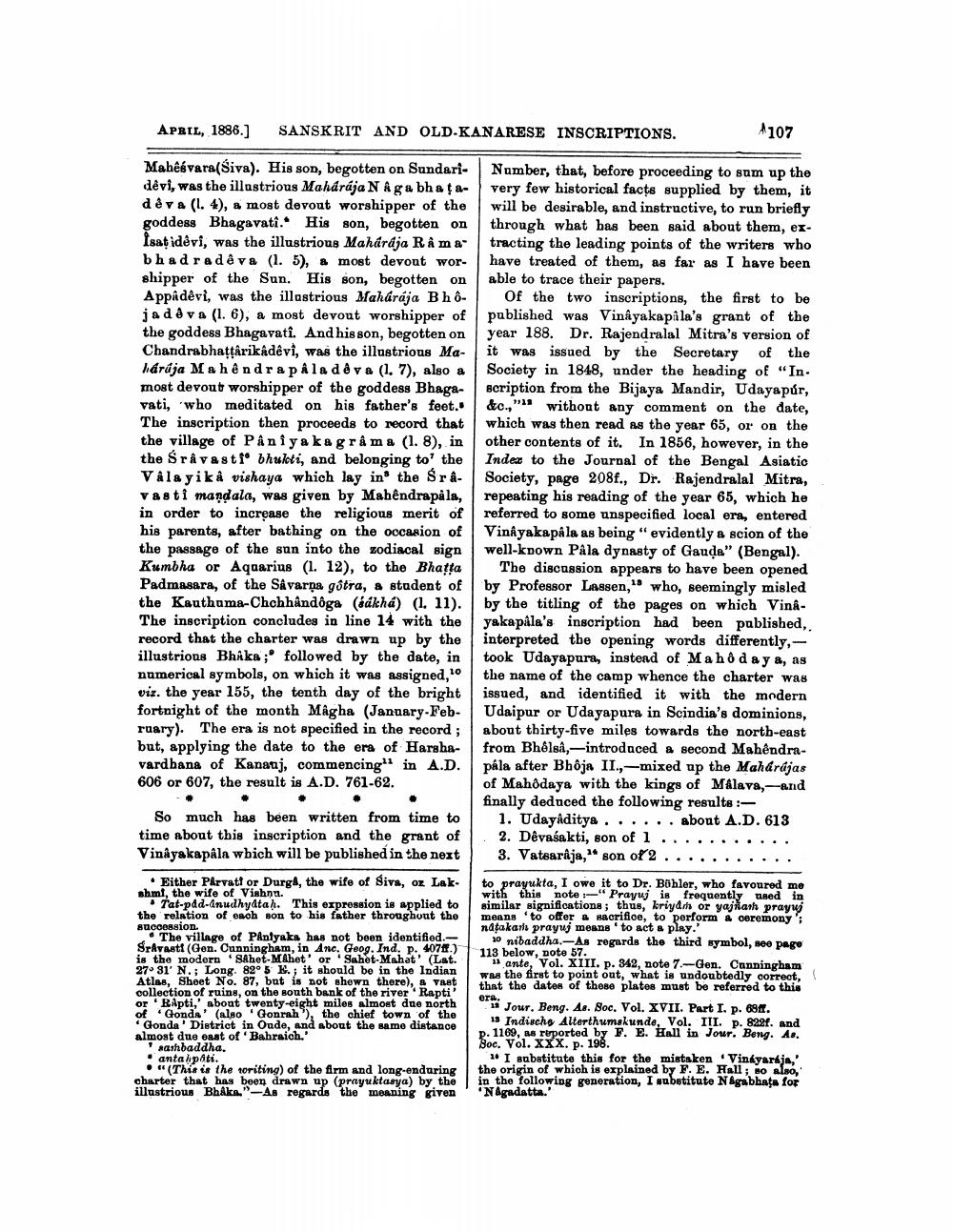________________
APRIL, 1886.]
Mahêévara(Siva). His son, begotten on Sundaridevi, was the illustrious Mahárája Nâ ga bhatadêva (l. 4), a most devout worshipper of the goddess Bhagavati. His son, begotten on Isaṭidevi, was the illustrious Maharaja Rà ma bhadradêva (1. 5), a most devout worshipper of the Sun. His son, begotten on Appâdêvi, was the illustrious Mahárája Bhôjadeva (1. 6), a most devout worshipper of the goddess Bhagavatî. And his son, begotten on Chandrabhaṭṭârikâdêvi, was the illustrious Mahárúja Mahendra pâladêva (1. 7), also a most devout worshipper of the goddess Bhagavati, who meditated on his father's feet. The inscription then proceeds to record that the village of Pâniya kagrama (1. 8), in the Sravasti bhukti, and belonging to the Vâlayika vishaya which lay in the Śrâvasti mandala, was given by Mahendrapala, in order to increase the religious merit of his parents, after bathing on the occasion of the passage of the sun into the zodiacal sign Kumbha or Aquarius (1. 12), to the Bhatta Padmasara, of the Sâvarna gotra, a student of the Kauthuma-Chchhândôga (éákhá) (1. 11). The inscription concludes in line 14 with the record that the charter was drawn up by the illustrious Bhaka; followed by the date, in numerical symbols, on which it was assigned,10 viz. the year 155, the tenth day of the bright fortnight of the month Mâgha (January-February). The era is not specified in the record; but, applying the date to the era of Harshavardhana of Kanauj, commencing in A.D. 606 or 607, the result is A.D. 761-62.
So much has been written from time to time about this inscription and the grant of Vinayakapâla which will be published in the next
SANSKRIT AND OLD-KANARESE INSCRIPTIONS.
Either Parvati or Durga, the wife of Siva, or Lakshmi, the wife of Vishnu.
Tat-pad-anudhyataḥ. This expression is applied to the relation of each son to his father throughout the succession.
The village of Pantyaka has not been identified.Sravasti (Gen. Cunningham, in Anc. Geog. Ind. p. 407.) is the modern Sahet-Mähet' or 'Sahet-Mahat' (Lat. 27° 31' N.; Long. 82° 5 E.; it should be in the Indian Atlas, Sheet No. 87, but is not shewn there), a vast collection of ruins, on the south bank of the river Rapti' or Rapti,' about twenty-eight miles almost due north of Gonds (also Gonrah"), the chief town of the Gonda' District in Oude, and about the same distance almost due east of 'Bahraich.'
9
sashbaddha.
antaḥpiti.
A107
Number, that, before proceeding to sum up the very few historical facts supplied by them, it will be desirable, and instructive, to run briefly through what has been said about them, extracting the leading points of the writers who have treated of them, as far as I have been able to trace their papers.
Of the two inscriptions, the first to be published was Vinayakapila's grant of the year 188. Dr. Rajendralal Mitra's version of it was issued by the Secretary of the Society in 1848, under the heading of "Inscription from the Bijaya Mandir, Udayapúr, &c.," without any comment on the date, which was then read as the year 65, or on the other contents of it. In 1856, however, in the Index to the Journal of the Bengal Asiatic Society, page 208f., Dr. Rajendralal Mitra, repeating his reading of the year 65, which he referred to some unspecified local era, entered Vinayakapála as being "evidently a scion of the well-known Pâla dynasty of Gauda" (Bengal).
"(This is the writing) of the firm and long-enduring charter that has been drawn up (prayuktasya) by the illustrious Bhaka."-As regards the meaning given
The discussion appears to have been opened by Professor Lassen, who, seemingly misled by the titling of the pages on which Vinâyakapala's inscription had been published,.. interpreted the opening words differently,took Udayapura, instead of Mahodaya, as the name of the camp whence the charter was issued, and identified it with the modern Udaipur or Udayapura in Scindia's dominions, about thirty-five miles towards the north-east from Bhôlsâ,-introduced a second Mahendrapála after Bhôja II.,-mixed up the Maharajas of Mahodaya with the kings of Malava,-and finally deduced the following results:
1. Udayaditya. . . . . . about A.D. 613 2. Dêvasakti, son of 1
3. Vatsaraja, son of 2
to prayukta, I owe it to Dr. Bühler, who favoured me with this note" Prayuj is frequently used in similar significations; thus, kriyam or yajah prayuj means to offer a sacrifice, to perform a ceremony naṭakam prayuj means to act a play."
10 nibaddha.-As regards the third symbol, see page 113 below, note 57.
11
ante, Vol. XIII. p. 342, note 7.-Gen. Cunningham was the first to point out, what is undoubtedly correct, that the dates of these plates must be referred to this
era.
1 Jour. Beng. As. Soc. Vol. XVII. Part I. p. 68ff.
13 Indische Alterthumskunde, Vol. III. p. 822f. and p. 1169, as reported by F. E. Hall in Jour. Beng. As. Boc. Vol. XXX. p. 198.
1 I substitute this for the mistaken Vinéyarája,' the origin of which is explained by F. E. Hall; so also," in the following generation, I substitute Nagabhata for 'Nagadatta.'




